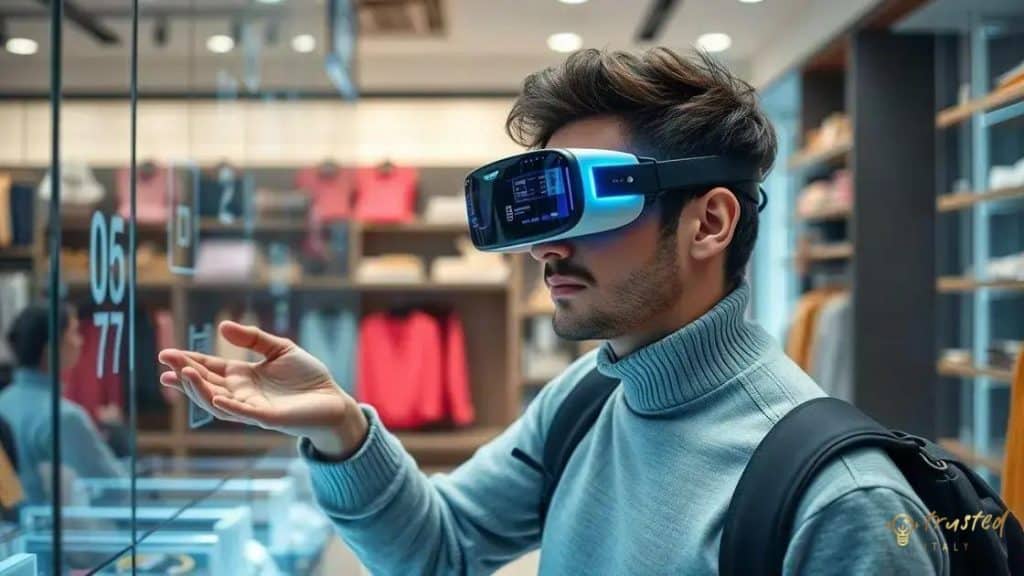The future of augmented reality in entertainment and retail

The future of augmented reality in entertainment and retail involves enhanced personalization through AI integration, improved technology, and a wider adoption across various sectors, transforming user experiences significantly.
The future of augmented reality in entertainment and retail promises to change the way we experience shopping and media. Have you imagined stepping into a digital world where products come to life right before your eyes? Let’s explore this intriguing landscape.
Understanding augmented reality technology
To understand augmented reality technology, we need to look at how it combines the physical and digital worlds. Augmented reality (AR) enhances our real-life experiences by adding digital elements, making it possible to see and interact with virtual objects in our environment.
The core of augmented reality relies on advanced technologies, including computer vision, simultaneous localization and mapping (SLAM), and depth tracking. These elements work together to recognize surfaces and objects, allowing for seamless integration of virtual content.
How AR Technology Works
Essentially, AR uses cameras and sensors from devices like smartphones and smart glasses to gather information about the surrounding environment. By processing this data, AR can superimpose digital images over the real world.
- Camera and Sensor Input: These collect real-time data from the environment.
- Processing: The device analyzes the data to identify how to place virtual objects.
- Display: Finally, the augmented visuals are projected back into the user’s field of vision.
As AR continues to evolve, its applications are becoming more sophisticated. From gaming to health care, industries are leveraging this technology to provide immersive experiences. For instance, in gaming, players can interact with characters that blend into their surroundings, making gameplay more engaging.
Benefits of Augmented Reality
The use of AR comes with numerous advantages. It enhances user interaction and improves learning by allowing visual and interactive content. This makes understanding complex subjects much easier. Moreover, businesses employing AR can offer customers unique experiences, enhancing brand loyalty.
- Improved Engagement: Users are more likely to interact with brands using AR.
- Enhanced Learning: Dynamic visuals help simplify complex information.
- Increased Sales: Innovative AR experiences can boost product sales.
In summary, understanding augmented reality technology opens the door to a myriad of opportunities across different sectors. As this technology matures, its impact on our daily lives will only increase, making it an exciting area to watch.
Applications in retail environments

The applications of augmented reality in retail environments are transforming how customers shop. Retailers are now using this technology to provide interactive experiences that enhance product visibility and engagement.
By integrating AR, stores can create immersive shopping experiences. For instance, customers can use smartphones or AR glasses to visualize products in their own space before making a purchase. This method reduces uncertainty and allows for a more informed decision-making process.
Innovative Uses of AR in Retail
One way retailers utilize AR is through virtual fitting rooms. Shoppers can try on clothes or accessories virtually without physically wearing them. This not only saves time but also adds a fun element to the shopping experience.
- Virtual Try-Ons: Customers can see how clothing or makeup would look on them.
- Product Visualization: Items, like furniture, can be placed in a customer’s home through their device.
- Interactive Displays: Stores can enhance product displays with AR content that showcases features and benefits.
Moreover, AR apps can guide customers through stores, providing information about deals, features, and product locations. This enhances customer experience by making navigation easier and more informative.
Benefits of Using AR in Retail
Implementing augmented reality can lead to increased sales and customer satisfaction. Shoppers enjoy personalized experiences, and brands benefit from higher engagement. By using AR, retailers can stand out in a competitive market, offering something unique that keeps customers coming back.
- Enhanced Customer Engagement: Interactive experiences foster a deeper connection between brands and consumers.
- Reduce Purchase Anxiety: AR helps customers feel more confident in their buying choices.
- Increased Conversion Rates: Engaging shopping experiences translate into higher sales.
As technology advances, the use of augmented reality in retail will likely expand. Retailers adopting this innovative approach can enhance overall shopping experiences and attract a wider audience.
The role of AR in enhancing entertainment experiences
The role of augmented reality in enhancing entertainment experiences is significant and transformative. It allows users to engage with media content in new and exciting ways. By blending digital elements with the real world, AR heightens enjoyment and interaction.
In gaming, for example, augmented reality takes play to another level. Players can immerse themselves in interactive worlds that merge seamlessly with their surroundings. This creates a more realistic gaming experience where characters and objects appear to exist in the same space as the player.
Innovative Applications in Entertainment
Augmented reality also enriches how we experience movies and live events, making them more engaging. Some films include AR features that allow viewers to unlock additional content or interact with characters.
- Interactive Storytelling: AR makes narratives more engaging by allowing users to participate in storylines.
- Enhanced Live Events: Concerts and sports can provide real-time data through AR applications, augmenting the live experience.
- Virtual Tours: Museums now use AR to give visitors added information about exhibits, enhancing learning opportunities.
These experiences are not just limited to gaming or films. Through AR, theme parks are introducing attractions that respond to user interactions, allowing guests to become part of the action.
Benefits of AR in Entertainment
The benefits of using augmented reality in entertainment are vast. It creates unique experiences that can capture audience interest and build loyalty to brands. With AR, entertainment becomes more personalized and interactive.
- Increased Engagement: Audiences are more likely to stay captivated with interactive content.
- Memorable Experiences: Unique AR elements can make events unforgettable, encouraging repeat attendance.
- Broader Audience Reach: AR can help attract varied demographics, appealing to both tech-savvy and traditional audiences.
With its growing presence in entertainment, augmented reality is setting new standards for how we consume and enjoy media. As technology improves, the potential for memorable and interactive experiences will continue to expand.
Challenges faced by AR in mainstream adoption

Despite the exciting potential of augmented reality (AR), there are several challenges that hinder its mainstream adoption. These obstacles can slow down the growth and use of AR in various sectors.
One significant challenge is the high cost of developing AR applications. Creating engaging and effective AR experiences often requires substantial investment in technology and expertise. Many businesses are hesitant to commit these resources, especially if the return on investment (ROI) is unclear.
Technical Limitations
Another challenge involves the technological limitations of devices. While smartphones and tablets have made AR more accessible, not all devices can support advanced AR features. This restricts the quality and types of experiences that can be offered to users.
- Device Compatibility: Not every consumer has access to the latest technology needed for optimal AR experiences.
- Battery Life: AR applications can drain battery life quickly, making extended use inconvenient.
- Internet Connectivity: Many AR applications require a strong internet connection, limiting usability in areas with poor service.
User experience is also a concern. If AR applications are not intuitive and easy to use, they may frustrate users instead of engaging them. For AR to thrive, it must seamlessly integrate into everyday activities without being overly complicated.
Market Perception
A final significant barrier is market perception. Many consumers are still unaware of what AR can offer or may have misconceptions about its utility. Education and effective marketing are crucial to changing these perceptions and gaining user trust.
- Lack of Understanding: Some users may not fully grasp how AR can be beneficial in their lives.
- Privacy Concerns: Users may worry about data collection and privacy issues related to AR applications.
- Resistance to Change: Many people prefer traditional methods, leading to reluctance in adopting new technologies.
Addressing these challenges is essential for the growth of augmented reality and its eventual acceptance in mainstream markets. As technology evolves and awareness increases, the future of AR looks promising, but these hurdles must be overcome first.
Future trends in augmented reality
The future trends in augmented reality (AR) are shaping how we interact with technology. As advancements continue, AR will become more integrated into everyday life, enhancing various sectors such as retail, education, and entertainment.
One exciting trend is the improvement of hardware. Devices like AR glasses are becoming lighter and more user-friendly. This means that users will find it easier to adopt AR in daily activities. As technology evolves, we can expect to see higher-quality visuals and more interactive features.
Increased Integration with AI
Another significant trend is the integration of augmented reality with artificial intelligence. This combination will enhance user experiences by providing more personalized content. As AR systems learn user preferences, they can deliver tailored notifications and suggestions, making interactions smoother and more engaging.
- Smarter Environments: AI-driven AR can recognize locations and suggest relevant content based on context.
- Enhanced Interactivity: Users will be able to interact with digital content in more intuitive ways.
- Personalized Experiences: AR can adapt to individual user habits and preferences over time.
Educational tools are also likely to benefit significantly from future AR innovations. We can anticipate immersive learning experiences that allow students to engage with subjects in new ways. For example, medical students could practice procedures in a safe, controlled AR environment.
Broader Adoption in Business
Businesses are expected to adopt AR technologies more widely for training, marketing, and customer engagement. Companies can create unique promotional experiences that captivate customers and drive sales, transforming the way they interact with brands.
- AR Marketing Campaigns: Interactive ads that engage consumers directly will become more common.
- Training Simulations: Organizations will utilize AR for creating realistic training modules for employees.
- Remote Assistance: AR can facilitate real-time guidance for customers and technicians in the field.
As augmented reality continues to develop, it will play a crucial role in enhancing our interactions with digital content. These future trends suggest that AR is not just a fleeting technology but is here to stay, promising exciting developments for users and businesses alike.
FAQ – Frequently Asked Questions about Augmented Reality
What is augmented reality (AR)?
Augmented reality is a technology that overlays digital information onto the real world, enhancing the user’s perception and interaction with their environment.
How is AR used in retail?
AR in retail allows customers to visualize products in their own spaces, try on virtual clothes, and interact with advertisements to enhance the shopping experience.
What are some challenges facing AR adoption?
Challenges include high development costs, device compatibility issues, and general user awareness of AR technology.
What future trends can we expect in AR?
Future trends include improved AR devices, greater integration with artificial intelligence, and wider adoption across various industries such as education and entertainment.